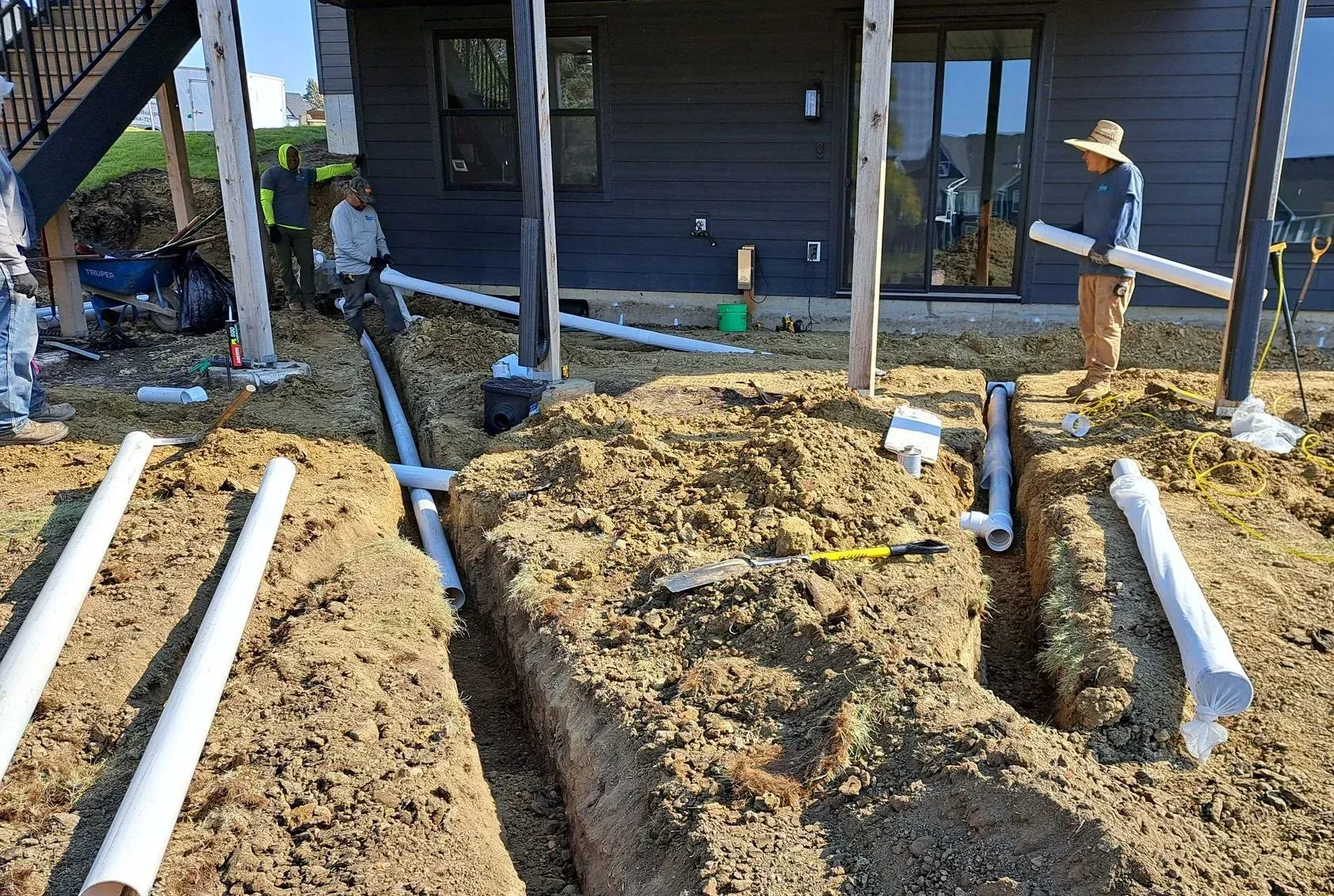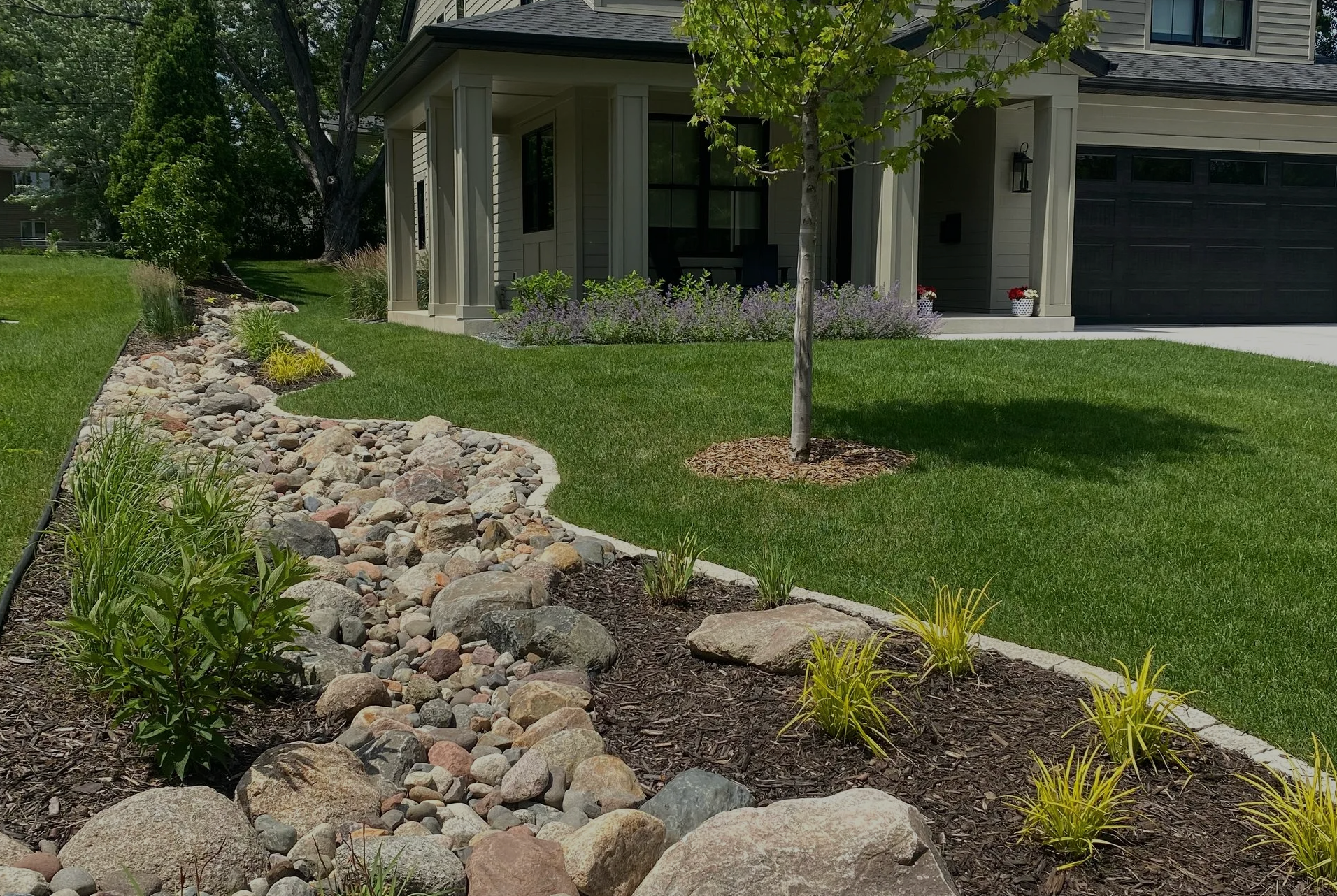Fixing Drainage in Plymouth’s Clay Soil Yards: Lasting Solutions for Tough Conditions
Most Homeowners Think Drainage Is About Moving Water. In Plymouth, It’s About Managing Clay Soil.

In many areas, drainage means guiding water away from the foundation and letting the soil do the rest. Plymouth is different. Nearly every property here sits on heavy clay soil, and clay doesn’t behave like loam or sand. Instead of absorbing water, it saturates quickly and then sheds it across the surface.
I’ve seen the consequences of treating Plymouth yards like “normal” soil: sump pumps running constantly, lawns that stay muddy for days, patios cracking after a few winters, and expensive landscapes failing long before their time. These aren’t just nuisances—they’re signs that the wrong systems were installed.
That’s why drainage here isn’t just about redirecting water. It’s about engineering solutions that respect how clay behaves. When systems are designed properly, they protect foundations, keep outdoor spaces usable, and extend the life of every other landscape investment.
Here’s what we’ll cover:
- Why Plymouth’s clay soil creates unique challenges.
- The systems that actually work: underground downspouts, sump pump discharge, drain tile, and grading.
- How professional installation protects long-term value.
- What to expect in terms of cost, planning, and maintenance.
By the end, you’ll know exactly how to approach drainage in Plymouth—and how to avoid costly do-overs.
Understanding Plymouth’s Clay Soil Challenge
That reality becomes clearer once you understand how Plymouth’s clay soil actually behaves. Unlike sandy or loamy soils that let water filter through naturally, clay acts like a sponge that soaks up water until it’s saturated, then sheds it across the surface.
This leads to three common problems:
- Soggy lawns that stay unusable long after storms.
- Foundation stress as sump pumps cycle endlessly.
- Landscape damage when patios and plantings fail due to frost heaving and water saturation.
I often meet homeowners who realize this only after investing in landscaping. A new patio starts settling, plantings struggle, or lawn areas never dry out. Each issue traces back to unmanaged clay soil.

Underground Downspout Systems: Foundation-Level Protection
Once you understand the soil itself, the next step is tackling the single biggest source of water around Plymouth homes—roof runoff. Every storm sends thousands of gallons off the roof, and if that water dumps directly onto clay soil near the foundation, soggy lawns and basement moisture are almost guaranteed.
Underground downspout systems solve this by channeling roof water into buried PVC pipes that discharge in safe areas—storm drains, engineered basins, or natural low spots. This prevents runoff from saturating clay around the foundation and reduces the burden on sump pumps.
The installation must be precise: proper slope, correct pipe sizing, and discharge locations that don’t just move the problem elsewhere. Coordinating these systems with patios or other excavation work saves time and cost.
Pro Tip: Plan downspouts during landscape design—even if installation happens later. Routing pipes under finished patios is disruptive and expensive.
Sump Pump Discharge Solutions: Eliminating the Muddy Mess
But downspouts are only half the story. In Plymouth, sump pumps are everywhere, and without the right discharge system, they create as many problems as they solve. The flexible black tubing most homeowners use leaves trenches in lawns, interferes with mowing, and freezes solid in winter.
Permanent underground discharge systems are the answer. They connect directly to the sump pump outlet and carry water safely underground to discharge points that can handle the volume. The result is a yard that stays dry, even during heavy pump cycles.
This upgrade eliminates muddy messes, reduces foundation moisture, and keeps systems working year-round—even in January when temporary tubes freeze solid.
Pro Tip: Size discharge lines for maximum pump output, not average flow. In clay soils, sudden surges can overwhelm undersized systems.

Drain Tile Systems: Managing Subsurface Water in Clay Soil
If downspouts and sump pumps handle surface water, drain tile goes deeper. It manages the water that clay soil holds below ground. Perforated pipes are installed underground, letting saturated clay “bleed” water into the system. Gravity then carries it away to safe discharge areas.
When installed correctly, drain tile transforms unusable lawns into dry, functional spaces. But it must be engineered carefully:
- Pipes must be pitched at precise slopes.
- Backfill choice matters. Using sandy material around pipes dramatically improves performance compared to backfilling with clay.
In Plymouth, sandy backfill is often worth the upgrade—it helps water reach the pipe faster, protecting patios and plantings above.
Grading and Foundation Protection: First Line of Defense
Of course, even the best underground systems can’t function if grading directs water toward the foundation. In clay soils, improper grading amplifies every problem.
Professional grading corrects slopes, reshaping ground to send water away from the house and toward discharge areas. In Plymouth, this often means reworking areas that settled after construction or reshaping spaces for new patios and plantings.
Clay expands and contracts dramatically with weather changes, so grading here requires techniques that remain stable through freeze-thaw cycles. When paired with drain tile and downspouts, grading creates the first—and most important—line of defense against water problems.
Professional Installation Techniques for Clay Soil Conditions
Once grading and system design are in place, success comes down to installation. Clay changes everything—it compacts differently, retains water, and requires specialized techniques that many contractors overlook.
Experienced crews use equipment that minimizes compaction, materials that account for clay’s movement, and integration strategies that protect irrigation, patios, and plantings during installation. Quality control matters too: testing slope, ensuring discharge routes work, and backfilling with the right materials all affect long-term performance.
I’ve been called in to fix too many failed systems where shortcuts were taken—pipes laid flat, wrong materials used, or irrigation destroyed during excavation. With clay soil, those mistakes show up quickly.
Pro Tip:
Ask contractors for specific Plymouth references. Experience with clay soil projects separates systems that last from those that fail in a few seasons.
Protecting Your Investment: Why Drainage Comes First
And because expertise determines results, it also protects your investment. Drainage may not be glamorous, but it underpins everything else in your landscape. Without it, patios fail, lawns stay soggy, foundations crack, and plantings never thrive. With it, every dollar you spend on landscaping is protected.
Yes, drainage often represents 10–15% of project budgets. But compare that to the cost of replacing failed patios, rebuilding walls, or repairing water-damaged basements, and the investment pays for itself many times over.
Timing matters too. Installing drainage during larger landscape projects minimizes disruption and ensures systems support outdoor features rather than conflict with them.
FAQs
How do Plymouth’s clay soils change drainage design compared to other areas?
Clay doesn’t drain—it holds water. That means systems here must capture and redirect both surface and subsurface water. Where sandy soils allow water to filter naturally, Plymouth requires engineered solutions like PVC downspouts, drain tile, and grading.
Can professional drainage reduce sump pump use?
Yes. When water is managed before it reaches the foundation, sump pumps run far less. I’ve seen homes where pumps cycled nonstop before improvements, only to drop to occasional use afterward. That reduces energy costs, equipment wear, and basement moisture risk.
What’s the typical investment for drainage systems in Plymouth?
Comprehensive solutions usually cost $8,000–$25,000. Underground downspouts and grading are the most affordable starting points, while drain tile systems represent a higher investment. For homeowners planning $25k+ landscapes, drainage is the insurance policy that protects it all.
When’s the best time of year to install drainage systems?
Spring through fall works, but dry ground allows for the cleanest installations. Many homeowners pair drainage work with patios or planting projects to minimize disruption.
Can drainage be phased over time?
Absolutely. Many families start with downspouts and grading, then add drain tile or sump discharge later. The key is designing the full system upfront so later phases don’t undo completed work.
Do drainage systems require much maintenance?
Not much. Annual inspections and occasional cleaning of catch basins usually suffice. Compared to ongoing sump pump stress, muddy lawns, and patio repairs, professional drainage is far less demanding.
How does proper drainage affect resale value?
Buyers in Plymouth know clay soil headaches. Homes with documented professional drainage stand out, offering peace of mind that future owners won’t face constant sump pump issues or failing landscapes. That reassurance directly boosts property value.
Building Landscapes That Last in Plymouth’s Clay Soil
Fixing drainage in Plymouth isn’t optional—it’s the foundation for everything else. With engineered systems that account for clay’s unique behavior, you protect your home, preserve your landscaping, and create outdoor spaces that last.










